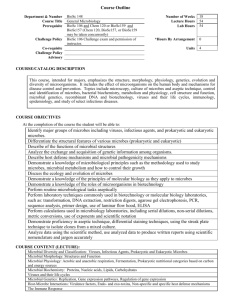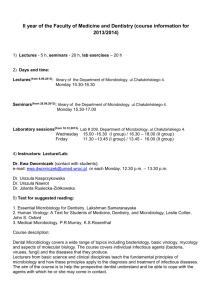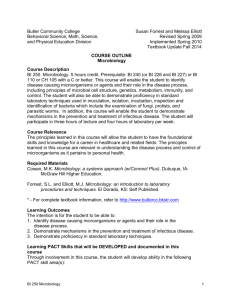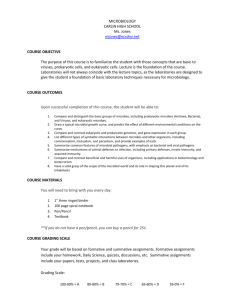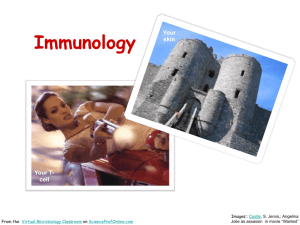College Microbiology Class Study Guide
advertisement
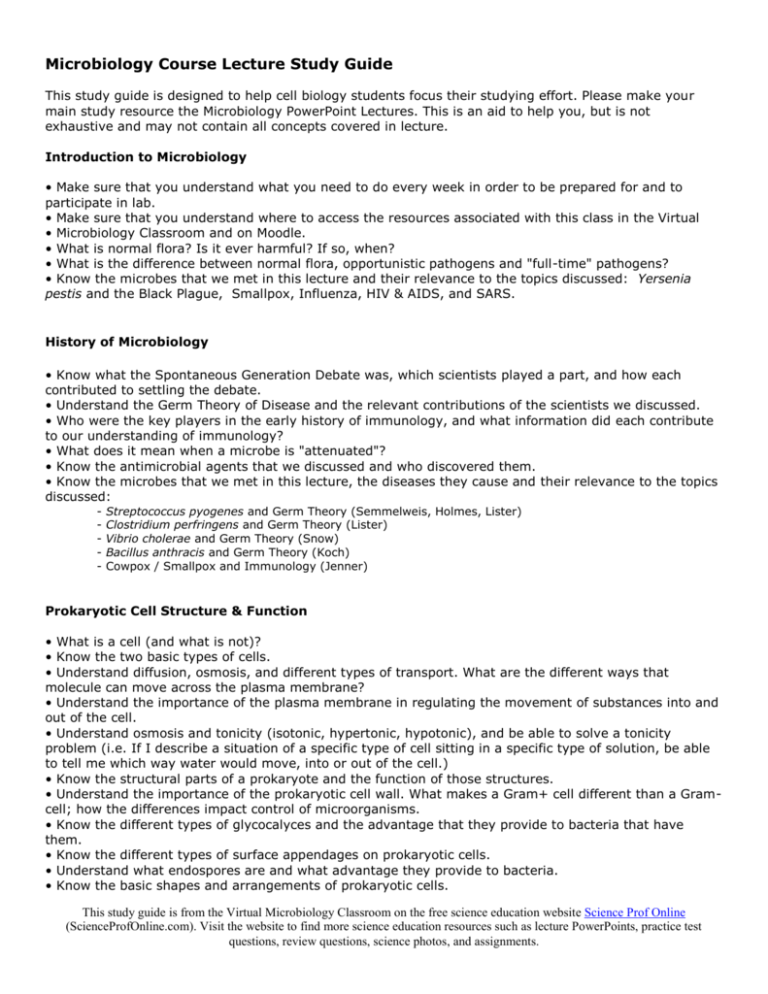
Microbiology Course Lecture Study Guide This study guide is designed to help cell biology students focus their studying effort. Please make your main study resource the Microbiology PowerPoint Lectures. This is an aid to help you, but is not exhaustive and may not contain all concepts covered in lecture. Introduction to Microbiology • Make sure that you understand what you need to do every week in order to be prepared for and to participate in lab. • Make sure that you understand where to access the resources associated with this class in the Virtual • Microbiology Classroom and on Moodle. • What is normal flora? Is it ever harmful? If so, when? • What is the difference between normal flora, opportunistic pathogens and "full-time" pathogens? • Know the microbes that we met in this lecture and their relevance to the topics discussed: Yersenia pestis and the Black Plague, Smallpox, Influenza, HIV & AIDS, and SARS. History of Microbiology • Know what the Spontaneous Generation Debate was, which scientists played a part, and how each contributed to settling the debate. • Understand the Germ Theory of Disease and the relevant contributions of the scientists we discussed. • Who were the key players in the early history of immunology, and what information did each contribute to our understanding of immunology? • What does it mean when a microbe is "attenuated"? • Know the antimicrobial agents that we discussed and who discovered them. • Know the microbes that we met in this lecture, the diseases they cause and their relevance to the topics discussed: - Streptococcus pyogenes and Germ Theory (Semmelweis, Holmes, Lister) Clostridium perfringens and Germ Theory (Lister) Vibrio cholerae and Germ Theory (Snow) Bacillus anthracis and Germ Theory (Koch) Cowpox / Smallpox and Immunology (Jenner) Prokaryotic Cell Structure & Function • What is a cell (and what is not)? • Know the two basic types of cells. • Understand diffusion, osmosis, and different types of transport. What are the different ways that molecule can move across the plasma membrane? • Understand the importance of the plasma membrane in regulating the movement of substances into and out of the cell. • Understand osmosis and tonicity (isotonic, hypertonic, hypotonic), and be able to solve a tonicity problem (i.e. If I describe a situation of a specific type of cell sitting in a specific type of solution, be able to tell me which way water would move, into or out of the cell.) • Know the structural parts of a prokaryote and the function of those structures. • Understand the importance of the prokaryotic cell wall. What makes a Gram+ cell different than a Gramcell; how the differences impact control of microorganisms. • Know the different types of glycocalyces and the advantage that they provide to bacteria that have them. • Know the different types of surface appendages on prokaryotic cells. • Understand what endospores are and what advantage they provide to bacteria. • Know the basic shapes and arrangements of prokaryotic cells. This study guide is from the Virtual Microbiology Classroom on the free science education website Science Prof Online (ScienceProfOnline.com). Visit the website to find more science education resources such as lecture PowerPoints, practice test questions, review questions, science photos, and assignments. Prokaryotic Cell Structure & Function (continued) • Understand how the shape of bacterial cells impacts the cell arrangements they occur in. • Know the microbes that we met in this lecture and their relevance to the topics discussed. - Streptococcus and bacterial slime layer - Clostridium bacteria and endospores - Neisseria gonorrhoeae and bacterial fimbriae Eukaryotic Cell Structure & Function • Understand differences and similarities between prokaryotic and eukaryotic cells • Know the structural components of eukaryotic cells (organelles & other cellular components). • Know which cellular components are found only in eukarotes, only in prokaryotes and those found both in prokaryotes and eukaryotes. • What is the endomembrane system and what does it do? Do prokaryotes have an endomembrane system? • Name and describe two energy-producing organelles in eukaryotic cells. Biological Classification • What kind of evidence do scientists use to categorize and classify living things? • Hierarchy of biological classification has nine major taxonomic ranks. What are they? • Know the three domains and the forms of life each represents. • Binomial nomenclature: Genus species; Know how to properly write the generic and specific name of a species. • What is a dichotomous key? How many choices are at each decision point? Prokaryotes: Meet the Microbes • Understand the three types of Archaea that we discussed. • Know the three levels of hierarchy in biological classification (out of the nine we discussed) are we mainly going to be referring to in this class. • Understand the difference between Gram-positive and Gram-negative bacterial cell walls. • Know the information presented on the Gram-positive bacterial genera and species that we discussed. • Name and describe the bacterial genera that produce endospores. Are they Gram-positive or Gramnegative? • Which species of bacteria are considered Gram-variable? Why? • What is different about the cell wall structure of acid-fast bacteria when compared to the Gram-positive bacterial cell wall? • How is blood agar (BAP) useful in distinguishing between the pathogen Streptococcus pyogenes and normal flora? • Know the information presented on the Gram-negative bacterial genera and species that we discussed. • How is MacConkey's agar useful in identifying different types of Gram-negative bacteria? • Describe the important differences between encapsulated and unencapsulated Haemophilus influenzae. • How is the life cycle of Chlamydia different than that of most bacteria? This study guide is from the Virtual Microbiology Classroom on the free science education website Science Prof Online (ScienceProfOnline.com). Visit the website to find more science education resources such as lecture PowerPoints, practice test questions, review questions, science photos, and assignments. Eukaryotes: Meet the Microbes • Know which groups of microscopic eukaryotes cause disease in humans, and which do not. • Know the different eukaryotic microorganisms that were presented in the lecture PPT, and any information about specific representative genera or species that was detailed, such as Giardia, Entamoeba histolytica, Blastomyces dermatitidis, Aspergillus fumigatus & Hookworms. • Know, and be able to distinguish between, the four main categories of mycoses. • How are fungal infections commonly transmitted, and how well do we understand their prevalence? • What is the difference between true and opportunistic fungal pathogens. Be able to name the four true fungal pathogens. • What are helminths? Why are these comparatively large microbes studied by microbiologists? Virus Structure • Understand what viruses are and how they differ from living organisms. • Be able to describe the four types of genetic material that viruses can be made of. • Understand the difference between an enveloped and non-enveloped virus. • What are the three main structural elements that viruses can be made of. Which of these structural elements is not present in all viruses? • Describe the different shapes of viruses. Virus Life Cycle • • • • • Know the difference between the viral intracellular and extracellular states. Understand the different ways that viruses can get into and out of cells. Compare and contrast the entry and exit of bacteriophages with that of animal viruses. What is a bacteriophage? Explain what transduction is, and how it relates to bacteriophages and their host bacteria. Viruses: Meet the Microbes • Understand the difference between an enveloped and non-enveloped virus? • Viruses have one of four different basic types of genomes. For each virus described in this lecture, know its genome type and whether it is enveloped or non-enveloped. • Know the names and descriptions of the different types of herpes viruses. • HIV (Human-immunodeficiency-virus) is a retrovirus. Understand the key difference between a retrovirus and other types of viruses. • Know which type of viruses can cause the common cold • Be able to describe what HPV, is and its relationship to cancer. • Understand what a hidden virus is. • Know what a prophage is, and what is necessary for a virus to be a prophage. • Be able to describe the difference between modified live and killed virus vaccine. Microbial Genetics • • • • Compare features of viral, prokaryotic and eukaryotic genomes. What is DNA made of? Know the structural components. Understand the process of replication. (Don’t let the brief sentence fool you; this is a lot of complex info. Make sure you understand it to the level that was presented to you in the lecture PPTs). This study guide is from the Virtual Microbiology Classroom on the free science education website Science Prof Online (ScienceProfOnline.com). Visit the website to find more science education resources such as lecture PowerPoints, practice test questions, review questions, science photos, and assignments. Microbial Genetics (continue) • What does semi-conservative replication mean? • What is a replication bubble? • •Understand the processes of transcription & translation. (Don’t let the brief sentence fool you; this is a lot of complex info. Make sure you understand it to the level that was presented to you in the lecture PPTs). • What nucleic acid base is used in the construction of RNA that is not utilized in DNA molecules? What nucleic acid based is not used in RNA molecules that is used in the construction of DNA? • How is transcription similar to replication? How is it different? • What types of RNA are involved in translation and what are their roles? • What is the ‘triple code’? What is its role in the structure of proteins build through translation? • Specifically, what is a mutation? • What is the difference between vertical and horizontal gene transfer? • Compare and contrast the three types of horizontal gene transfer that we discussed in class. • Know the microbes that we met in this lecture and their relevance to the topics discussed. - Staphylococcus and gene expression - Streptococcus pneumoniae and horizontal gene transfer Microbial Metabolism • Understand difference between catabolism / anabolism and what these reactions have to do with metabolism. • Understand what a redox reaction is and what this type of reaction has to do with metabolism. • Understand what ATP is and its significance in metabolism. • Understand the steps of aerobic cellular respiration to the detail that we discussed in class (starting molecule, end product molecule, what is produced in each pathway or subpathway. You do not need to know the name of every molecule at every substage of these processes). • Understand how aerobic respiration, anaerobic respiration and fermentation differ. • Understand how metabolism relates to the differential aspect of MacConkey's and Mannitol Salt specialized media. Microbial Growth • Explain what “microbial growth” means. • Know the 4 phases of the microbial growth curve. • Understand how microorganisms are grouped based on their relationship with oxygen, temperature, pH, salt & pressure. • How does bacterial generation time relate to characteristics of disease? (Another “think” question.) • Understand what it means for binary fission to result in exponential growth. • Understand the different factors that affect bacterial growth and how they influence the speed of population growth. Know any terminology associated with these factors. • Know the microbes that we met in this lecture and their relevance to the topics discussed. - Mycobacterium tuberculosis and Generation time Mycobacterium leprae and Generation time Chlamydomonas nivalis and Temperature Listeria monocytogenes and Temperature Helicobacter pylori: pH & Oxygen Campylobacter jejuni and Oxygen Vibrio cholorae and pH Staphylococcus epidermidis and Osmostic Pressure This study guide is from the Virtual Microbiology Classroom on the free science education website Science Prof Online (ScienceProfOnline.com). Visit the website to find more science education resources such as lecture PowerPoints, practice test questions, review questions, science photos, and assignments. Immunology: Innate Immunity • Describe microbial antagonism. • Understand the first line of immune defense against pathogens; its physical components and chemical components • What is the role of mucus in helping protect us from infection? • Understand how leukocytes, nonspecific chemical defenses, inflammation and fever contribute to our second line of defense against pathogens. • Describe the three types of formed elements • List the different types of leukocytes and their functions. • Understand which leukocytes are involved in the second line of defense. • Know the three types of cells that kill extracellularly. • Be able to list and describe the nonspecific chemical defenses of the second line of immune defense. • Understand the steps of the inflammatory response. • What is the relationship between gram negative bacteria and fever? Immunology: Acquired Immunity • Which leukocytes are part of nonspecific immune function? Which are part of specific immune function? • What is our third line of defense against pathogens? What are its components? • Understand what antigens are, and be able to describe the different types. • Be able to describe what an epitope is. What is another term for epitope? • Understand what antibodies are, what they can do, and which cell type produces them. • What are antigen presenting cells? • What is the major histocompatibility complex and MHC glycoproteins. • Know the function and components of the lymphoid system to the level that we discussed in lecture/PPT. • Know the different types of lymphocytes and their functions. • What are B cells? Name the types and describe what they do. • What are B-cell receptors? How is their function different from MHC molecules? • What are T cells? Name the types and describe what they do. • What are T-cell receptors? How is their function different from MHC molecules? • What is the humoral immune response? Which cells and chemicals are involved? • What is the relationship between B-cells and T-cells in the humoral immune response? • What is cell-mediated immune response? Which cells and chemicals are involved?What are cytokines? • What are interleukins? • What is the difference between specific and nonspecific immune function? Which aspects of immune function are nonspecific and which are specific? This study guide is from the Virtual Microbiology Classroom on the free science education website Science Prof Online (ScienceProfOnline.com). Visit the website to find more science education resources such as lecture PowerPoints, practice test questions, review questions, science photos, and assignments. This study guide is from the Virtual Microbiology Classroom on the free science education website Science Prof Online (ScienceProfOnline.com). Visit the website to find more science education resources such as lecture PowerPoints, practice test questions, review questions, science photos, and assignments.


